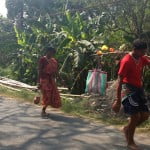 Bengaluru has seen warm summers in recent years, but there’s something different this time. Everyone is aghast that the city has seen several days over the past month when daytime temperatures have been higher than sweltering Chennai. Where are the pleasantly cool evenings? Where are the showers that cooled the city down after a few warm days? What happened to the city whose weather would earn it comparisons with hill stations?
Bengaluru has seen warm summers in recent years, but there’s something different this time. Everyone is aghast that the city has seen several days over the past month when daytime temperatures have been higher than sweltering Chennai. Where are the pleasantly cool evenings? Where are the showers that cooled the city down after a few warm days? What happened to the city whose weather would earn it comparisons with hill stations?
Bengaluru had its first spell of pre-monsoon showers in early April, alleviating, but only a little, the brutality of the summer. The heatdescended on the city as early as February when the city recorded a temperature of 35.5 degrees Celsius on February 22 – four degrees above normal and the hottest February day in more than 10 years. Night temperatures recorded at that time were three degrees above normal.
In March 2015, private weather forecaster Skymet reported that March temperatures were unusually high by Bengaluru standards. In the last 10 years, Bengaluru’s temperature crossed the 36 degree Celsius mark only three times – in 2005, 2013 and in 2014 – and only at the very end of March. In 2015, temperatures spiked in mid-March. This year, day and night temperatures have been significantly above normal even before March 15.

Some Bengaluru neighbourhoods have experienced five degrees more heat than they did last year, according to data gathered by remote environment sensing start-up Yuktix. Yuktix, which makes devices to record weather patterns, has been installing small automatic weather stations across the city to record temperature and other data. Rajeev Jha, the founder of Yuktix, compared temperature trends for Jayanagar and HSR Layout in south Bengaluru for 2015 and 2016 to find a dramatic increase in the maximum and minimum temperatures this year.




“The interesting thing is that for HSR Layout, the spread is more than Jayanagar or Hebbal,” said Jha, while emphasising that he is not a climatologist but a device maker. Jha feels that this difference may be due to more concrete surfaces in HSR Layout.
Last year, Jha compared data between stations located in open areas with little construction, like the grounds of the University of Agricultural Sciences, and a locality called Vidyaranyapura, which is close to the university but populated with buildings. He found that the open spaces didn’t heat up very quickly and maintained a temperature equilibrium, while areas with a lot of concrete showed temperature spikes.
Jha’s findings fit in with the phenomenon of urban heat islands seen around the world – metropolitan areas that are warmer than their surroundings because of human activities. Urban heat islands are created by heat discharge due to energy consumption, larger land surfaces plastered over with artificial materials that have high heat capacities and less cooling when vegetation and water bodies are lost.
Scientists from the Center for Ecological Studies at the Indian Institute of Science in Bengaluru have documented the emergence of the urban heat island in Bengaluru in a 2010 paper. The study showed that the urban areas of the city grew by 632% in the years between 1973 and 2009. That growth, accompanied by a 76% loss of vegetation cover and a 79% decline of the city’s water bodies could have caused the cities temperatures to rise between 2 and 2.5 degrees Celsius in the first decade of the 21st century.
Given the sorry state of Bengaluru’s lakes, the unabated and unregulated construction across the city and the continued loss of vegetation, it shouldn’t really surprise anyone that the forecast for the coming week shows highs of 38 degree Celsius for the city.
[“source-Scroll”]




